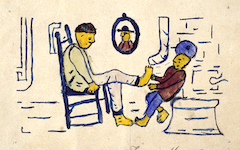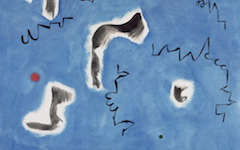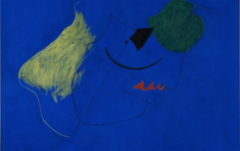Miró‘s Woman and Bird in front of the Moon (1944)

Miró, Femme et Oiseau devant la Lune (1944) Oil, pastel and gouache on unstretched canvas. Private Collection
Click image to enlarge.
The woman in Miró's 1944 Woman and Bird in front of the Moon stands on the left with a black torso, black arms and a yellow sun-like eye. Above and behind her is the moon. Black clouds or thoughts, with a touch of red and green, appear to waft through her mind from the moon. The bird is perhaps the calligraphic flourish in what resembles black ink at her feet. Yet before we interpret the composition as a whole, let's see what else is happening.
Click next thumbnail to continue
The woman's torso and arms are formed from an M while the first stroke of the flourish is a lower case I. That, in turn, as in handwriting, is joined to an unmistakeable R.
Click next thumbnail to continue
The Ó, the last letter of Miró's name with a diacritical accent, was after the M his favorite letter. They appear, mostly unseen and unreported, all over his work even when the I and R are missing, leaving only the first and last letter, an M and an Ó. Here the Ó doubles as the woman's left eye and intentionally resembles a spermatozoa as well.
Click next thumbnail to continue
Now that we know from the M in her torso of Miró's self-representation in the woman we can recognize her as the "artist" with a solar eye inside a fertile green oval which is itself a vertical eye-form. This yellow eye represents the artist's external perception while his (or her) other eye, solid black and thus representing insight, has floated off to the right. With sperm as one "eye" the mind of this feminine "Miró" is surely androgynous as the minds of all true artists must be.
Click next thumbnail to continue
The bird in the title might either be that calligraphic flourish or, I imagine, the red dot with three legs. Either way birds are common in Miró's compositions and often represent both the flights of his imagination and the ability of his inner eye to perceive the whole, a philosophical viewpoint depicted through an apt visual metaphor for a visual artist, the bird's ability to gain an aerial perspective.
See conclusion below
There is much more to excavate but, now that you are aware of Miró's basic structure, one he often used, whatever you see in the future will be built on a firmer foundation. Like so many other poetic artists, Joan Miró illustrates his own mind. Enjoy digging into it. I do.
More Works by Miró
Notes:
Original Publication Date on EPPH: 27 Oct 2012. | Updated: 0. © Simon Abrahams. Articles on this site are the copyright of Simon Abrahams. To use copyrighted material in print or other media for purposes beyond 'fair use', you must obtain permission from the copyright owner. Websites may link to this page without permission (please do) but may not reproduce the material on their own site without crediting Simon Abrahams and EPPH.







